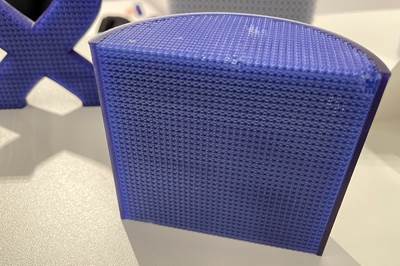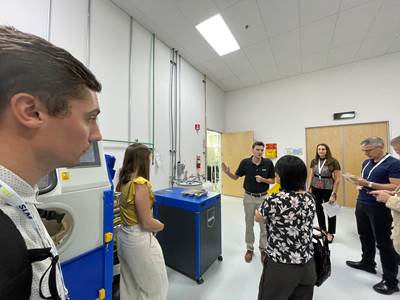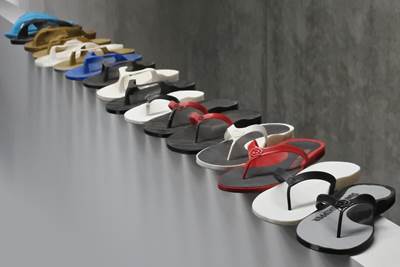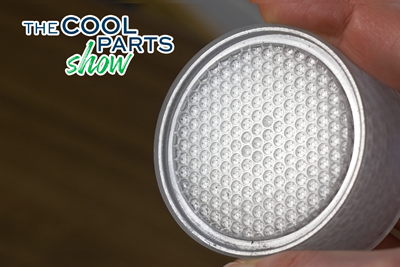Design for Additive Manufacturing (DFAM)
Additive design may mean modifying an existing conventional design for 3D printing purposes, or starting from scratch with a true design for additive manufacturing (DFAM) mindset. Additively manufactured designs often aim for assembly consolidation and lightweighting. They are conducive to biomimicry and complex geometries that optimize negative space and are achieved through generative design or topology optimization. The initial design step considers printing processes, materials, support structures and downstream steps like depowdering and postprocessing.

ESSENTIAL READING
VIEW ALL3MF File Format for Additive Manufacturing: More Than Geometry
The file format offers a less data-intensive way of recording part geometry, as well as details about build preparation, material, process and more.
Read MoreImplicit Modeling for Additive Manufacturing
Some software tools now use this modeling strategy as opposed to explicit methods of representing geometry. Here’s how it works, and why it matters for additive manufacturing.
Read MoreThe AM Ecosystem, User Journeys and More from Formnext Forum Austin: AM Radio #43
Sessions and conversations at the first U.S. Formnext event highlighted the complete additive manufacturing ecosystem, sustainability, the importance of customer education, AM user journeys and much more.
ListenIn Additive Manufacturing, Is There a Case for Separating Design From Production? AM Radio #25A
Design and 3D printing must inform each other, but keeping them under separate ownership can benefit the designer, the producer and the consumer. More in this podcast episode.
ListenThe 12-Month Transformation of a 3D Printed Product's Design
Rapid product development and continuous improvement are among the advantages of utilizing 3D printing for production. Retraction Footwear offers a literal illustration of the design evolution possible in just one year.
Read MoreGenetic Engineering for Metal: The Promise of Microstructure Control via Additive Manufacturing
“To design the alloy, design the microstructure,” says this Ohio materials science startup. Artificial intelligence is helping to realize a design tool for determining the properties of 3D printed metals.
Read MoreLatest Design News And Updates
Nikon Corp. Opens California Technology Center to Provide Customer Support
The center offers a variety of solutions and services aimed at accelerating customer adoption, scaling and supply chain in metal additive manufacturing.
Read MoreCoreTechnologie Optimizes AI-Supported 3D Nesting Software for Higher Efficiency
The new version of the universal 3D printing software 4D_Additive 1.6 features an AI-supported nesting technology, which enables an average 30% increase in efficiency when operating SLS and MJF printers compared to the previous version and other common nesting tools.
Read MoreOhio-Based Startup Rebrands as Vixiv
The beta version of the company’s software addresses only weight reduction applications, while future versions will address other design goals.
Read MoreNext Generation nTop Modeling Software Enables Faster Design, Greater Precision
The nTop 5 software is said to represent a major advance in implicit modeling, and includes integrations from five new partners to advance the design-to-manufacturing workflow.
Read MoreItalian Furniture Maker Uses WASP Technology to Create 3D Printed Pendant Lamps
The versatility of 3D printed ceramic enabled the designers to shape a weave reminiscent of the beehive concept, enhanced by the light source.
Read More3YourMind Partners With Nigeria’s RusselSmith to Develop Spare Parts for Oil, Gas Industry
RusselSmith is using 3YourMind’s software to identify viable parts for optimization and production using additive technology. Optimized parts will then be added to a digital inventory interface, enabling RusselSmith to streamline pricing, delivery and order operations for its customers.
Read MoreFeatured Posts
Bike Manufacturer Uses Additive Manufacturing to Create Lighter, More Complex, Customized Parts
Titanium bike frame manufacturer Hanglun Technology mixes precision casting with 3D printing to create bikes that offer increased speed and reduced turbulence during long-distance rides, offering a smoother, faster and more efficient cycling experience.
Read More3D Printing Solutions to Support Investment, Sand Casting
3D Systems is highlighting a design strategy for better investment casting patterns, as well as a new machine suitable for the production of patterns for sand casting.
Read MorePreassembled Turbojet Engine, 3D Printed in One Build: The Cool Parts Show #75
Turbojet engines typically consist of hundreds or thousands of parts, but this engine — 2023 winner of The Cool Parts Showcase for Best Proof of Concept — was 3D printed as just two pieces, with the monolithic rotor embedded inside the stationary engine shell.
WatchFeatured Media
Video: Orbit X Pro Football Helmet Uses 3D Printed Lattices
The lightweight helmet from Xenith will be used by NFL and collegiate football players beginning in fall 2024.
WatchAdditive Manufacturing at NASA (Part 1): AM Radio #51
In this first episode of a two-part special on additive manufacturing at NASA, we discuss three specific 3D printed parts for upcoming missions and share observations about the organization’s approach to AM.
ListenUltra-Complex 3D Printed Scaffolds Enable Cell Growth: The Cool Parts Show #70
Perhaps the ultimate surface-area challenge is in bioengineering: creating structures that can grow sufficient cells within a compact volume to be effective for leading-edge medical treatments. The Southwest Research Institute develops bioreactor scaffolds that could only be made using 3D printing.
WatchFAQ: Design
What do you use to create a design for 3D printing or additive manufacturing?
Ultimately, 3D printing designs are created using CAD software and then prepared for 3D printing with a slicer that divides the model into layers. This software allows a designer to create 2D and 3D designs.
What is topology optimization?
Topology optimization mathematically configures a design and material distribution to most efficiently meet predetermined parameters such as size and strength.
“So what topological optimization is saying is I've got these loads and I'm going to remove material in order to minimize the amount of material that I have. And it's actually a fairly simple process of putting a load on, looking where the stresses are, where there's no stresses, reduce the stiffness and the density, and keep doing that until you get holes and your part is going to work.”
–Eric Miller, of Phoenix Analysis & Design Technologies, discussing the difference between topology optimization and generative design with Additive Manufacturing Media’s Stephanie Hendrixson.
What should designers remember when creating negative space in a 3D printed part?
When designers include channels in their parts, they often forget that these features don’t have to be bound to the shape of a simple round hole. With 3D printing, holes and channels can be any shape that provides proper support for the build.
Why are interior radii important when designing for 3D printing?
Parts that look sharp shouldn’t necessarily have sharp edges. In fact, with 3D printed parts, it’s better to look smooth. Whenever possible, use interior radii for edges and corners. That smooth contour not only has a great look, but it has the benefit of relieving the stresses that build up during the printing process.
What is lightweighting in additive manufacturing?
Lightweighting is producing a part that weighs less than a similar part made through another manufacturing process. Additive manufacturing’s ability to provide complex geometries with internal passages often results in a lighter part compared to a conventionally manufactured part. More negative space means less weight.
This microturbine is an example of a lightweighting success.
What are complex geometries in additive manufacturing?
Complex geometries are shapes and designs that are intricate or could be difficult to create with conventional manufacturing options. For example, a part that requires interior coolant delivery will need channels that not only deliver fluid, but also allow for the fluid to exit the part. With conventional manufacturing, this could demand the production of multiple parts that must then be assembled or machined. However, additive manufacturing can produce a single part with built-in channels that can be in almost any shape, not just round holes.
An example of a complex geometry made possible only by additive manufacturing is this heat exchanger that uses gyroids for better cooling.


























